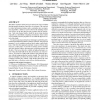116 search results - page 19 / 24 » Suballowable sequences of permutations |
WADS
1989
Springer
13 years 11 months ago
1989
Springer
rees can be used for representing abstract data types such as dictionaries and ordered lists. They work well when the elements are inserted in a random order. Some sequences of ope...
STACS
2010
Springer
14 years 2 months ago
2010
Springer
Abstract. A Boolean function on N variables is called evasive if its decision-tree complexity is N. A sequence Bn of Boolean functions is eventually evasive if Bn is evasive for al...
IEEEPACT
2006
IEEE
14 years 1 months ago
2006
IEEE
The address sequence on the processor-memory bus can reveal abundant information about the control flow of a program. This can lead to critical information leakage such as encryp...
PODC
2003
ACM
14 years 26 days ago
2003
ACM
This paper considers the problem of performing tasks in asynchronous distributed settings. This problem, called DoAll, has been substantially studied in synchronous models, but th...
ECAI
2008
Springer
13 years 9 months ago
2008
Springer
Abstract. Some constraint problems have a combinatorial structure where the constraints allow the sequence of variables to be rotated (necklaces), if not also the domain values to ...

